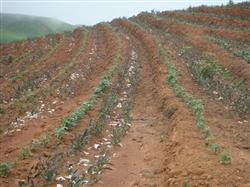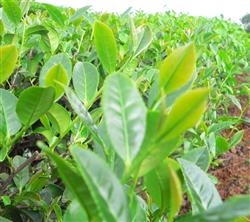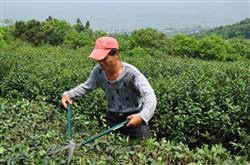Tea planting techniques: how to manage the soil in the tea garden?

How to manage the soil in the tea garden? Please introduce the method that the soil management of tea garden is one of the important technical measures to achieve high quality and high yield. Its main purpose is to control weeds, improve soil physical and chemical properties, promote the proliferation of beneficial microorganisms, and create a very favorable underground environment for the good growth and development of tea trees. 1. The time and depth of soil ploughing hoe in conventional adult tea garden (1) the time and depth of ploughing hoe in adult tea garden vary greatly due to different natural climatic conditions and cultivation techniques, but they can be divided into shallow ploughing in spring and summer and deep ploughing in autumn and winter. ① spring ploughing hoe. The time is from late February to mid-March, and the alpine tea area (more than 1200 meters above sea level) can be in early April. This shallow ploughing is generally carried out in combination with the application of spring fertilizer, with a depth of 7cm to 10cm. The aim is to loosen the soil, increase the ground temperature, supply nutrition and promote the germination and growth of spring tea. ② summer ploughing hoe. The end of a round of tea (about mid-late May) combined with the application of summer fertilizer, ploughing depth of 10-15 cm. Tea garden after spring picking and other agricultural activities, the soil surface has been trampled and hardened many times, hindering the circulation of air and the infiltration of Rain Water, and this is a period of vigorous weed growth, so summer ploughing and hoeing is very important. ③ ploughing. In late summer and early autumn (from late July to early August), the second round of tea was carried out with autumn fertilizer at the end of the second round, with a tillage depth of 10 cm to 15 cm. At this time, high temperature, strong light, and often accompanied by drought, timely tillage plays a significant role in completely killing weeds, promoting the activity of soil nitrifying bacteria and accelerating the decomposition of organic matter. ④ autumn ploughing. At the end of autumn and the beginning of winter (from late October to mid-November), the local upper part stopped growing with the application of winter fertilizer, with a tillage depth of 15-20 cm. This ploughing can not only increase soil organic nutrition and promote root growth with base fertilizer, but also accelerate soil natural weathering, release fertilizer and improve soil structure. lay a material foundation for the formation of a large number of spring buds (overwintering buds) in the following year. The deep ploughing of the adult old tea garden in autumn and winter can be done once a year. However, for tea gardens with dense roots and still in their prime, they do not need to be ploughed every winter, but once every two years, so as not to damage the roots and affect the development of tree potential and the yield of spring tea next year. (2) whether the ploughing hoe method and the tool ploughing hoe method are reasonable or not has a close relationship with tea tree growth and soil and water conservation, and also has a great influence on labor efficiency. When weeding, the ground close to the tea tree should be shallowly cut to minimize the damage to the tea root, and the "nest grass" concentrated in the cluster feet should be pulled out by hand. The weeds removed should be accumulated in the rows, died in the hot sun or transported out of the garden on a sunny day, and compost should be made. The method of weeding has a great relationship with soil and water conservation. In the tea garden on the slope, such as ploughing and weeding along the slope, it will expand the surface soil erosion and cause erosion, so it should be carried out along the contour line (or ladder). The direction of the first ploughing hoe and the second ploughing hoe should be exchanged and adjusted to avoid topsoil displacement. The time of ploughing hoe should be selected when the soil is slightly dry in sunny or rainy days, the soil is too wet, it is easy to agglomerate and difficult to cultivate, at the same time, the soil will be more consolidated because of the destruction of soil structure. Ladder-type tea garden should also carry out ladder wall management when farming. The ladder wall should not be dug with a hoe, but should be cut with a knife to make the grass root deep in the soil to protect the ladder. Weeding tools, generally use board hoe, trouser knife, deep ploughing uses flat hoe, nail tooth rake and so on. Note that cattle ploughs must not be used, because ploughs will cause serious damage to tea roots and greatly reduce production the following year. If cattle ploughs are used every year, tea trees will grow badly and decline early in order to save labor and maintain the good structure of the soil. At present, it is best to use herbicides such as glyphosate for chemical weeding, and only when the ground is hardened can be supplemented by ploughing hoe, but in order to combine fertilization, tillage is still not exempt. 2. Soil management of densely planted no-tillage tea garden after 2-3 years of careful cultivation, a broad tea canopy can be formed to cover the whole ground. at this time, due to the shade of the ground, the weeds have lost their living conditions. The dense branches and leaves prevented Rain Water from hitting the ground directly, the water was slowly absorbed by the soil, the huge underground roots had covered the whole soil surface, a layer of litter was added to the ground to protect the soil water and heat stability, and the soil organic matter increased rapidly. Tea trees entered a period of exuberant growth. At this time, no-tillage conditions should be stopped, that is, ploughing hoe should be stopped, which plays a good role in promoting the further formation of good soil structure and improving the quality and yield of tea. The study shows that the growth of tea plant has little to do with the length of the main root, but has the most close relationship with the number and exuberance of the fine roots of the lateral root. Tillage of moving soil will inevitably damage a large number of roots and destroy the physiological balance of the aboveground and underground parts, resulting in a reduction in yield. In the experiment of Guizhou Tea Science Research Institute, ploughing and weeding in densely planted tea gardens lost as much as 5 kilograms of fine roots per 667 square meters, while tea production decreased with the increase of tillage times. For five consecutive years, the total yield in the farming area was 16.6% lower than that in the no-tillage area. The implementation of no-tillage after the closure of dense tea garden is not immutable, but it can be combined with crown renewal after a certain number of years, and at the same time, the soil can be adjusted periodically by deep ploughing and supplementary application of organic fertilizer. Click to get more tea planting techniques click to get more flower planting techniques
- Prev

Tea planting techniques: how do tea trees use pesticides?
How do tea trees use pesticides? Please give guidance on the use of pesticides in tea trees can refer to the following methods: 1. Reasonable selection of pesticides. Select the varieties of chemicals with high efficiency, low toxicity, low residue, safe to tea and natural enemies, no adverse effects and low cost, and master the characteristics and control objects of the agents. ...
- Next

Tea planting techniques: how to trim tea trees?
How to trim the tea tree? Please introduce that tea pruning is an artificial measure to restrain the growth advantage of top main branches, which can stimulate buds in lower growing parts to sprout new branches, enhance tree potential, and cultivate high-yield and high-quality crowns. The main pruning methods of tea trees are fixed pruning of young tea trees, light pruning and deep pruning of adult tea trees.
Related
- Fuxing push coffee new agricultural production and marketing class: lack of small-scale processing plants
- Jujube rice field leisure farm deep ploughing Yilan for five years to create a space for organic food and play
- Nongyu Farm-A trial of organic papaya for brave women with advanced technology
- Four points for attention in the prevention and control of diseases and insect pests of edible fungi
- How to add nutrient solution to Edible Fungi
- Is there any good way to control edible fungus mites?
- Open Inoculation Technology of Edible Fungi
- Is there any clever way to use fertilizer for edible fungus in winter?
- What agents are used to kill the pathogens of edible fungi in the mushroom shed?
- Rapid drying of Edible Fungi

